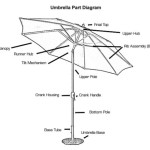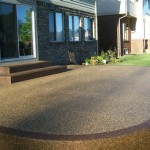Best Ways to Fix a Concrete Patio
A concrete patio provides a valuable outdoor living space. However, exposure to the elements, fluctuating temperatures, and general wear and tear can lead to various forms of damage over time. Addressing these issues promptly is crucial to preserving the patio's structural integrity, aesthetic appeal, and overall lifespan. Selecting the appropriate repair method hinges on the type and severity of damage present. This article explores several effective techniques for fixing concrete patios, outlining the steps involved and factors to consider in each scenario.
Identifying Common Concrete Patio Problems
Before embarking on any repair project, a thorough assessment of the concrete patio is necessary. Accurate diagnosis of the problem is indispensable for implementing the correct solution. Common issues include:
Cracks: Cracks are perhaps the most prevalent type of concrete patio damage. They can range from hairline fractures to wider, more significant fissures. Hairline cracks, often caused by shrinkage during the curing process, may be primarily cosmetic. However, larger cracks can indicate structural problems and allow water penetration, which can exacerbate the damage through freeze-thaw cycles.
Spalling: Spalling refers to the flaking or chipping of the concrete surface. This occurs when water permeates the concrete and expands upon freezing, causing the surface layer to break away. Spalling is particularly common in climates with cold winters and can significantly detract from the patio's appearance.
Pitting: Pitting is the formation of small, shallow depressions on the concrete surface. It's usually caused by chemical reactions, such as exposure to de-icing salts or acidic substances. While pitting may not immediately compromise the patio's structural integrity, it can worsen over time and create an uneven surface.
Settling: Settlement occurs when the soil beneath the concrete patio shifts or compacts, causing the patio to sink or become uneven. This can result in cracks and tripping hazards. The severity of the settling will dictate the appropriate repair method.
Discoloration and Stains: While not necessarily a structural issue, discoloration and stains can diminish the aesthetic value of the concrete patio. Stains can result from various sources, including oil, grease, leaves, and rust. Discoloration can also occur due to efflorescence, a white powdery deposit that forms when water-soluble salts migrate to the surface of the concrete.
Repairing Cracks in Concrete Patios
The approach to repairing cracks depends primarily on their width and depth. Small hairline cracks often require less intensive methods than larger, structurally significant cracks.
Hairline Cracks: For hairline cracks (less than 1/8 inch wide), a concrete crack filler or sealant is typically sufficient. The process involves:
- Cleaning the crack thoroughly with a wire brush to remove any loose debris or dirt.
- Applying the crack filler or sealant according to the manufacturer's instructions. Options include acrylic latex caulk, epoxy injection, or a concrete patching compound.
- Smoothing the filler with a putty knife to create a flush finish.
- Allowing the filler to cure completely before exposing the patio to traffic.
Larger Cracks: Wider cracks (greater than 1/8 inch) require a more robust approach to prevent further deterioration. The following steps are generally recommended:
- Widening the crack with a chisel and hammer to create a V-shaped groove. This provides a better surface for the patching material to adhere to.
- Cleaning the widened crack thoroughly with a wire brush and compressed air to remove any loose debris or dirt.
- Applying a concrete bonding adhesive to the inside of the crack to improve adhesion of the patching material.
- Mixing a concrete patching compound according to the manufacturer's instructions.
- Filling the crack with the patching compound, making sure to compact it tightly to eliminate air pockets.
- Smoothing the patch with a trowel to create a level surface.
- Curing the patch according to the manufacturer's instructions. This typically involves keeping the patch damp for several days to promote proper hydration and strength development.
For structurally significant cracks, especially those that are actively moving, professional assessment is advised. These cracks may require more extensive repairs, such as crack stitching or the installation of expansion joints.
Addressing Spalling and Pitting
Repairing spalling and pitting involves removing the damaged concrete and applying a new layer of patching material.
Preparation: The first step is to prepare the affected area. This involves:
- Removing any loose or crumbling concrete using a hammer and chisel or a concrete grinder.
- Cleaning the area thoroughly with a wire brush and compressed air to remove any dust or debris.
- Applying a concrete bonding adhesive to the prepared surface to enhance adhesion of the patching material.
Patching: Once the area is properly prepared, the patching process can begin:
- Mixing a concrete patching compound according to the manufacturer's instructions. Consider using a polymer-modified patching compound for improved durability and adhesion.
- Applying the patching compound to the prepared area, filling in the spalled or pitted areas.
- Leveling the patch with a trowel to create a smooth, even surface that blends seamlessly with the surrounding concrete.
- Texturing the patch to match the existing concrete surface. This can be achieved using a broom, sponge, or other texturing tools.
- Curing the patch according to the manufacturer's instructions. Proper curing is essential for achieving maximum strength and durability.
For extensive spalling, resurfacing the entire patio with a concrete overlay may be a more cost-effective and visually appealing option. Concrete overlays can provide a fresh, new surface and can be customized with various colors and textures.
Correcting Settled Concrete Patios
Addressing a settled concrete patio requires a different approach than repairing cracks or spalling. The goal is to lift the settled concrete back to its original level and stabilize the underlying soil.
Mudjacking: Mudjacking, also known as slabjacking, is a common method for lifting settled concrete. It involves:
- Drilling small holes through the concrete slab.
- Pumping a mixture of cement, soil, and water (the "mud") through the holes to fill the void beneath the slab.
- The pressure from the mudjacking mixture lifts the concrete slab back to its original level.
- Once the slab is lifted, the holes are patched with concrete.
Mudjacking is a relatively cost-effective and minimally invasive method for correcting settled concrete. However, it's important to choose a reputable contractor with experience in mudjacking to ensure proper execution and prevent further damage.
Polyurethane Foam Injection: Polyurethane foam injection is another method for lifting settled concrete. Similar to mudjacking, it involves drilling small holes through the concrete slab. However, instead of mud, a polyurethane foam is injected. The foam expands rapidly, filling the void and lifting the concrete.
Polyurethane foam injection offers several advantages over mudjacking. It's lighter and less invasive, and the foam cures quickly, allowing the area to be used sooner. However, it can be more expensive than mudjacking.
Replacing the Concrete Slab: In severe cases of settling, where the damage is extensive or the underlying soil is unstable, replacing the concrete slab may be the only viable option. This involves:
- Removing the existing concrete slab.
- Preparing the subgrade by compacting the soil and adding a layer of gravel for drainage.
- Pouring a new concrete slab.
Replacing the concrete slab is the most expensive and disruptive option, but it provides a long-term solution for severely settled concrete.
Preventive Measures for Concrete Patio Longevity
While repairs are sometimes necessary, proactive measures can significantly extend the life of a concrete patio and minimize the need for extensive fixes.
Sealing: Applying a concrete sealer is one of the most effective ways to protect a concrete patio from damage. Sealers create a barrier that prevents water and other substances from penetrating the concrete, thus reducing the risk of cracking, spalling, and staining. It is recommended to reseal the patio every one to two years, or as recommended by the sealer manufacturer. Select a sealer appropriate for outdoor use and specifically designed for concrete patios.
Proper Drainage: Ensuring proper drainage around the patio is crucial to prevent water from pooling and saturating the soil beneath. Slope the patio slightly away from the house to direct water away. Inspect and clean gutters and downspouts regularly to ensure they are functioning properly. Consider installing French drains or other drainage systems if necessary.
Prompt Stain Removal: Addressing stains promptly can prevent them from becoming permanent. Clean up spills immediately with a mild detergent and water. For tougher stains, use a concrete stain remover specifically designed for the type of stain (e.g., oil stain remover, rust stain remover).
Avoiding De-icing Salts: De-icing salts can accelerate the deterioration of concrete. If possible, avoid using de-icing salts on the patio. Instead, use sand or gravel for traction. If de-icing salts are unavoidable, use a calcium chloride-based product, which is less damaging to concrete than sodium chloride-based products.
Regular Cleaning: Regular cleaning helps to remove dirt, debris, and other contaminants that can damage the concrete surface. Sweep the patio regularly and wash it periodically with a mild detergent and water. A pressure washer can be used for more thorough cleaning, but use caution to avoid damaging the concrete surface.

Fix Your Ugly Concrete

5 Ways To Fix Ed Or Damaged Concrete Patio Cricket Pavers

Arlington Heights Concrete Repair Hero

The Best Way To Fix A Ed Patio

How To Repair And Resurface Old Concrete Patios Fixing Ugly

How Can I Salvage A Crumbling Ed 24x24 Concrete Patio Makeover Repair

How To Repair Concrete Patios Resurfacing Sealing Resin

Ed Concrete See How We Repaired Our Gross Patio 2024

Concrete Patio Repair 5 Ways To Improve Your

3 Concrete Resurfacing Options For Patio
Related Posts








